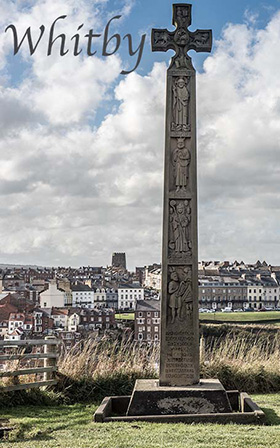


|
I first heard of the town of Whitby on the television series Heartbeat. The only thing I knew about it is that it is located on the eastern coast of England not far from the Yorkshire Moors. It is a York based tour of the Moors that brings me here. The tour, which will later take us to Goathland(Aidensfield), now stops near Bridge Street where we have a couple of hours to explore. |
Bridge Street is appropriately named as it runs along the bridge that crosses the River Esk. Bridges have crossed here since before 1351. The current electric swing bridge dates from 1908 - 09.

The view from the bridge provides a snapshot view of Whitby's economy based upon tourism supported by fishing. Today the catch is cod and haddock. In the past the main fish caught was herring. Whitby was also a whaling port.

The town is famous for its fish 'n' chips shops. Some claim they supply the best fish 'n' chips in the whole world. Maybe, but alas my palate isn't sensitive enough to distinguish between fish 'n' chips from different parts of the world. However, fish 'n' chips did provide fuel to climb the 199 steps to the Church of St Mary. I continued to Whitby Abbey.
Whitby Abbey, a ruined Benedictine Abbey, is located on the top of the East Cliff overlooking Whitby Harbour.

Founded by St Hilda in 657, building of a Gothic style abbey commenced in 1220 and was completed in 1500. The abbey, once disestablished by King Henty VIII in 1539, was bought by the Cholmley family.
The atmospheric ruins, perched on a hill top provided the inspiration for Bram Stoker's Dracula.
Making my way back through the tombstones, also featured in Bram Stroker's novel I entered the Church of St Mary.
Founded around 1110, the church today services the Anglican community. There have been several alterations over the centuries. Its current interior dates mainly from the late 18th century.


The church is not far from the cliff edge which offers a good view over Whitby and along the beach towards Sands End.

Along the path back towards the 199 steps, is Caedmon's Cross.
The 20ft high Caedmon’s Cross, a late Victorian-style celtic cross, was set up in 1898 to commenorate the 7th century Anglo-Saxon poet, Caedmon. It is made from hard sandstone quarried from near Hadrian’s wall.

This highly decorated cross has several panels depicting various saints, kings and Biblical figures. On the east face (shown) are four panels, Christ in the act of blessing; King David playing a harp; the abbess Hilda; Caedmon in his stable. Caedmon, who lived most of his life at the St Hilda monastic community, died in 680.
Unfortunately time was running short, but I had enough to have a quick look at the harbour which is sheltered by two lighthoused piers. The west lighthouse, built in 1831, at 25.5m is higher than the east lighthouse (16.5m), built in 1855. Both lighthouses were fitted with new lights in 2011.

Though my short stay in Whitby came to and end I realised that I could spend two or three days here.